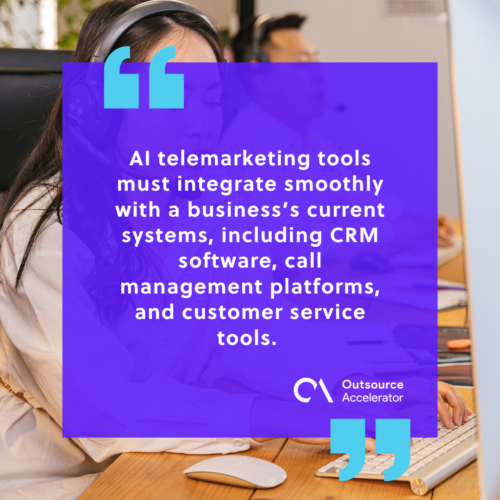AI telemarketing: Changing consumer outreach for good

Telemarketing has long been a cornerstone of sales and customer outreach, allowing businesses to connect directly with potential customers and generate leads.
But, over the years, the traditional methods of telemarketing have faced several challenges that heavily affect team performance.
Customer expectations will continuously increase along with intensified competition, so firms must constantly improve their strategies to stay relevant and effective. The need for speed, accuracy, and meaningful engagement has never been more pressing.
In response to these demands, a new approach is emerging—one that blends technology with human expertise to optimize the telemarketing process.
This approach not only streamlines operations but also offers enhanced personalization, more precise targeting, and greater efficiency.
As businesses look to modernize their outreach efforts, this innovative method is becoming a monumental step forward to customer engagement.
4 Common challenges in telemarketing
Telemarketing remains a vital instrument for customer outreach, but companies often face various challenges when trying to execute effective campaigns.
Understanding these obstacles is key to improving telemarketing strategies.
1. High rejection rates
One of the biggest challenges in telemarketing is dealing with high rejection rates. Many potential customers are reluctant to engage with unsolicited calls, leading to a high number of hang-ups.
This can be frustrating for agents and reduce campaign effectiveness.

2. Limited personalization
Traditional telemarketing often relies on scripted calls, which can feel impersonal and fail to engage customers on a deeper level. Without a personalized approach, customers are less likely to respond positively or show interest in the product or service being offered.
3. Compliance issues
Telemarketing is heavily regulated, with rules around calling times, opt-out procedures, and data protection.
Staying compliant with local laws can be complicated and time-consuming, risking fines or damage to a company’s reputation.
4. Resource intensive
Telemarketing campaigns can require significant resources, from hiring and training staff to managing call lists. This can become expensive, especially when results are inconsistent.
Addressing these challenges is critical for businesses to improve their telemarketing efforts and build stronger customer relationships.
How AI telemarketing addresses these challenges
AI telemarketing utilizes today’s innovations to make customer outreach more efficient, personalized, and compliant with regulations.
Here’s how artificial intelligence helps address common telemarketing challenges:
1. Reducing high rejection rates
AI telemarketing uses data-driven insights to target the right audience at the right time. AI systems analyze customer behavior and preferences to enhance call targeting, helping agents connect with prospects who are more likely to show interest in the offering.
This targeted approach reduces the likelihood of rejection and increases the chances of successful engagements.
2. Improving personalization
AI-powered systems can personalize each call based on customer data and previous interactions. For example, AI can dynamically adapt scripts, providing agents with tailored talking points to match a customer’s preferences or pain points.
This personalized approach leads to more meaningful conversations and a higher likelihood of conversion.
3. Addressing compliance issues
Telemarketing regulations are complex, but AI can automate compliance tasks, such as:
- Managing call times
- Recording opt-outs
- Ensuring data privacy
With AI handling these details, businesses can focus on delivering effective campaigns without worrying about violating rules or facing penalties.
4. Reducing resource intensity
AI chatbots and virtual assistants can handle routine tasks, like gathering customer information or answering frequently asked questions. This allows human agents to focus on more complex interactions, reducing the need for large teams and minimizing training costs.
Additionally, AI can scale up or down quickly, making campaigns more flexible and cost-effective.
6 Key considerations in AI telemarketing
Before adopting AI in telemarketing, there are several key considerations to fully leverage its potential:
1. Data quality and accuracy
AI relies heavily on data to make decisions and optimize campaigns. For AI to be effective in telemarketing, companies must have accurate, high-quality data.
Customer profiles, purchase history, and engagement patterns must be up-to-date to allow AI systems to generate meaningful insights.
Poor data can lead to inaccurate targeting and ineffective campaigns.
2. Integration with existing systems
AI telemarketing tools must integrate smoothly with a business’s current systems, including CRM software, call management platforms, and customer service tools.
A seamless integration allows AI to pull relevant data and provide agents with real-time insights, improving both the efficiency and effectiveness of outreach efforts. Without proper integration, AI can fall short of delivering the desired results.

3. Customer privacy and compliance
Privacy regulations like GDPR and CCPA set strict guidelines for how businesses handle customer data.
It’s crucial for companies to ensure their AI telemarketing systems comply with these rules. This includes obtaining consent for data collection, managing opt-out preferences, and safeguarding personal information.
Non-compliance can lead to legal repercussions and damage a business’s reputation.
4. Personalization capabilities
One of AI’s main strengths is its ability to personalize interactions. However, businesses must decide how much personalization is appropriate for their audience.
Over-personalizing can come off as intrusive, while too little can make the interaction feel impersonal. Striking the right balance is key to making AI-driven telemarketing successful.
5. Human-AI collaboration
While AI can handle many tasks, it cannot fully replace human interaction in all cases.
It’s essential to define where AI should take over (like answering common questions or lead qualification) and where human agents are needed to manage more complex, emotional, or nuanced conversations.
Having a clear strategy for human-AI collaboration will ensure smoother interactions.
6. Monitoring and optimization
Even with AI, regular monitoring is necessary to track campaign performance. AI tools can provide valuable insights into customer sentiment, call success rates, and engagement.
However, businesses must actively review these metrics to optimize campaigns and improve outcomes.
While AI offers great promise in telemarketing, firms must carefully consider data quality, system integration, compliance, personalization, and the role of human agents to maximize its benefits.







 Independent
Independent




